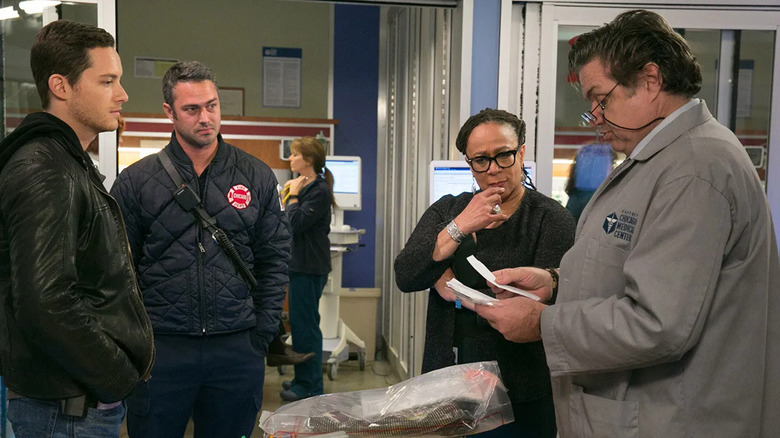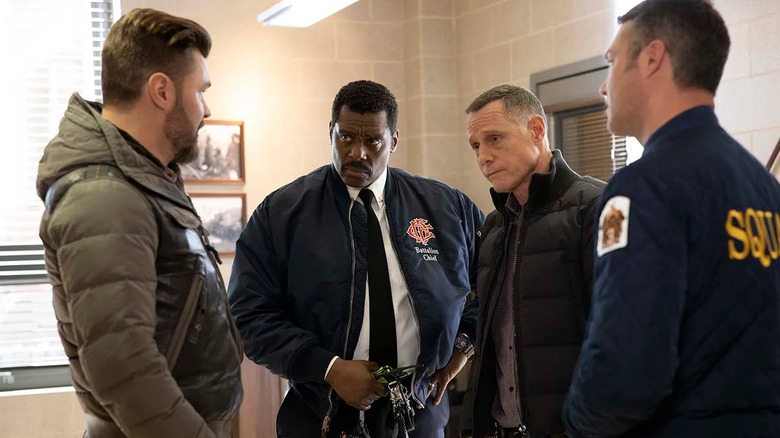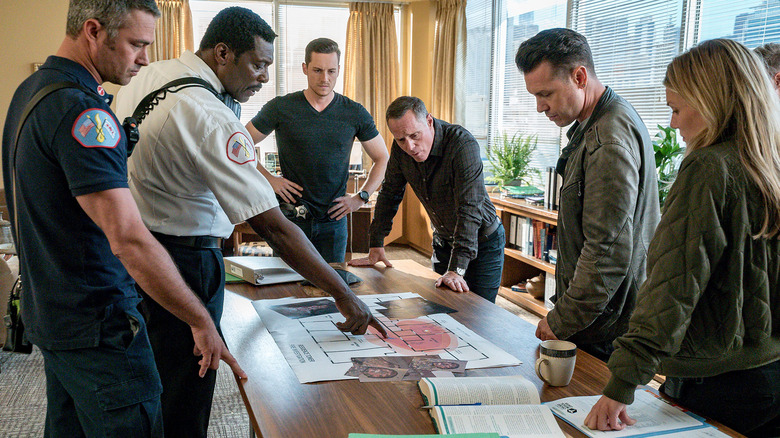The Best (And Worst) Chicago Fire Crossover Episodes
"Chicago Fire" has always thrived on crossovers. Whether it be with "Chicago P.D." or "Chicago Med" – the other members of the One Chicago universe — or dealing with the cops from "Law and Order," its characters have branched out into other shows regularly and have made a big impression on other series. While that intermixing of characters has generally slowed down over the past couple of seasons — partially due to COVID-19 protocols, partially due to the after-effects of the SAG-AFTRA strikes — it's always been a huge part of the DNA of "Chicago Fire."
The number of threads that connect the series to other shows in a permanent way are many. Its very own Randy "Mouch" McHolland (Christian Stolte) is married to "Chicago P.D." stalwart Trudy Platt (Amy Morton) — as a matter of fact, Trudy is more likely to pop up on "Chicago Fire" these days for a one-off plot than she is on "P.D." And, once upon a time, Gabriella Dawson's (Monica Raymund) brother Antonio (Jon Seda) was a huge part of the "Chicago P.D." world. With that in mind, one can see why whole episodes have been devoted to crossovers. Which are the best and which are the worst? Here's a short ranking of the highs and lows of the various shared narratives the series has enabled over the years.
The best crossovers show how interconnected One Chicago is
It's community that defines the best crossover episodes of "Chicago Fire." Anything that manages to go beyond the firehouse to loop in the police force, the hospital, or even the courthouse is bound to be a huge crowd-pleaser. For example: 2019's "Infection" three-parter pits the entire One Chicago universe against necrotizing fasciitis, or flesh-eating bacteria. Intentionally released, the illness becomes a natural concern for all emergency personnel, and the "Chicago P.D." crew is looped in thanks to the criminal aspect of the bacteria's spread into the wild.
"Deathtrap" forms a sad three-piece narrative with "P.D." and the since-canceled "Chicago Justice": it sees a rave at a warehouse turn into an inferno that ultimately takes the life of Alvin Olinsky's (Elias Koteas) daughter Lexi (Alina Taber). "Fire" "P.D." and "Justice" tracks the crime from inception to investigation to trial in a unique way that brings their whole world together in pursuit of justice.
"A Dark Day" is considered one of the best "Chicago Fire" episodes, and there's a reason for that. When an explosion occurs at Chicago Gaffney Medical Center, the crew is called in to rescue the living, knowing the entire time that Gabriella Dawson and Matt Casey (Jesse Spencer) are there representing the station for a run. Hank Voight (Jason Beghe) is brought into the story via the investigation surrounding the bombing. It shows the wider community impact that the bombing wreaks upon the city, making for intense viewing.
The worst ones cloister characters away from each other
On the other hand, the weaker "Chicago Fire" crossovers all involve segmenting the show's characters away from the larger picture, leaving them in silos that don't serve the greater storyline. If one set of characters is favored over the other, then the entire experience proves a poorer experience for the viewers.
"Off the Grid," for instance, mainly serves to set up the exit of one "Chicago P.D." character — Sean Roman (Brian Geraghty). Individuals from "Chicago Fire" are involved in the plotline, but they don't feel vital to it. "Some Make It, Some Don't" pits the firehouse against the police station when Kelly Severide (Taylor Kinney) is blamed for a hit-and-run accident. It's very investigation-heavy and involves no firefighting derring-do, which makes Severide's inclusion in the plot feel extremely arbitrary.
One can find a much better example of such a plot in "What I Saw," where Cruz (Joe Minoso) goes undercover for Hank to ferret out a fireman who's been moonlighting as a robber, pitting city brass against both teams of public servants. While the number of less-than-great episodes may be few, they help make up a larger mosaic of the "Chicago Fire" world. Even at its weakest, the show can still tell a sizzling story.


